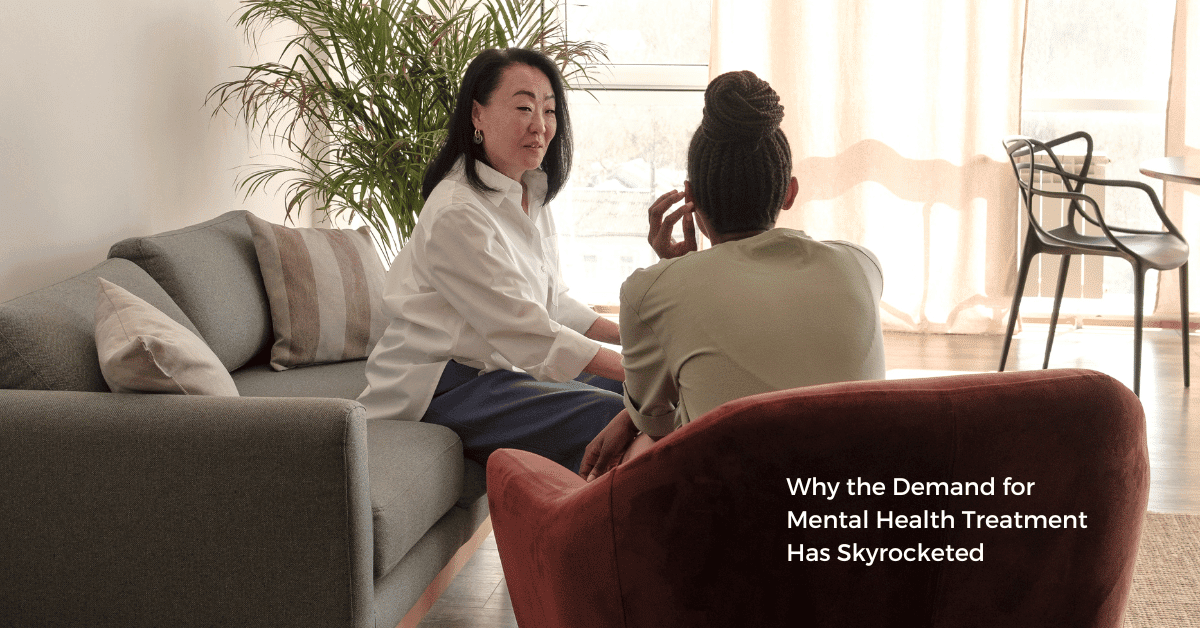Mental health is one of the most prevalent health issues facing our society, and the COVID-19 pandemic has exacerbated the problems it poses. As a result, the demand for mental services has skyrocketed as more and more people experience mental health struggles and seek help. Yet, the supply of mental health services has not expanded to accommodate this rising demand, resulting in fewer people accessing mental health treatment.
How COVID-19 Increased the Demand for Mental Health Services
The COVID-19 pandemic had wide-sweeping effects on society, politics and physical and mental health. It forced many of us to face incredibly stressful circumstances and prevented us from being close to the people who help support us. Because of these new stressors, the mandatory isolation and the fear born from uncertainty, many people developed stress and anxiety.
Since the beginning of the COVID-19 pandemic, 84% of psychologists reported an increase in patients with anxiety, and 72% reported the same for depression—a 10% increase from the year before the pandemic.
More and more people seek mental health care. The American Psychological Association has noticed a substantial increase in demand for such services, and the U.S. Surgeon General has identified the urgent need to address the youth mental health crisis. All this points to an ever-increasing demand for mental health services to address the mental health crisis spurred by the COVID-19 pandemic.
Higher Demand but Lower Capacity for Mental Health Services
The mental service market is not efficiently responding to the increased demand. Instead of developing additional programs and increasing capacity, it has been plagued by a shortage of human resources and reduced care provision.
The mental health provision industry is struggling to meet demand in terms of the workforce. Psychiatrists are often too rare, overworked and looking to retire, with 70% of practicing psychiatrists being 50 years or older and 77% of counties reporting a severe shortage of psychiatric care. As a result, experts anticipate that the U.S. will continue to face this shortage for at least the next three years.
Adding to this shortage of psychiatrists is a shortage of mental health programs. According to the National Council for Mental Wellbeing report, 54% of organizations closed programs while 65% canceled on or turned away patients in 2020. Because of these closures and cancellations, mental health services have sharply reduced capacity when increased capacity is desperately needed. So while the demand for mental health care has skyrocketed, the capacity to supply mental health care to meet demand simply isn’t there.
Low Accessibility of Mental Health Services
Reduced capacity is not alone in preventing the mental health industry from responding to increased demand—the cost of healthcare is also making mental health services even less accessible amid a crisis of capacity. Sadly, mental health struggles can be costly. Individuals with major depression spend an average of $10,836 on mental healthcare. Considering that the average household income was only around $67,000, asking someone to spend nearly $11,000, roughly a sixth of their income, on healthcare prevents many from accessing it.
.
Less Care for Those Who Need It Most
Reduced capacity, rising costs and increased demand have resulted in less care for many who desperately need it. As the Washington Post reported, one patient in Los Angeles attempted to contact 25 psychiatrists for mental healthcare, but none of them could accept a new patient.
Sadly, this is not an isolated example. Many healthcare providers and programs have waitlists that can be hundreds of people long, and 65% of psychologists say they have no room for new patients. All the while, mental health services are in very high demand and are extremely expensive, meaning that many people with mental illnesses will likely fall through the cracks of a system that cannot provide care for them.
Because of this, mental health care in America is facing a crisis. The program closures during the COVID-19 pandemic did not prepare for the mental illness fallout that would quickly follow the months of isolation, fear and uncertainty of 2020. Currently, the only real solution is to expand capacity, train new psychologists as quickly as possible and explore affordable innovations to make mental healthcare accessible. Without improved capacity, the people who need mental services the most will go untreated and be left behind.
A Parting Reminder
The rise in demand for mental health care is primarily due to the COVID-19 pandemic. Because of the pandemic’s inherent uncertainty and the forced social isolation, many people developed new cases of anxiety or depression, and others had their preexisting mental illnesses exacerbated. Unfortunately, mental health care providers did not anticipate this rise in mental health illness and, instead, reduced their capacity to provide care.
As a result, the rise in demand for mental health care has consumed the available capacity, preventing people now suffering from illnesses from getting treatment. This lack of capacity, high costs for care and dwindling numbers of psychologists mean that the U.S. faces a mental health crisis. Without an effort to increase the number of programs, psychologists and capacity and make mental healthcare affordable, many with mental illness will go uncared for.






0 Comments